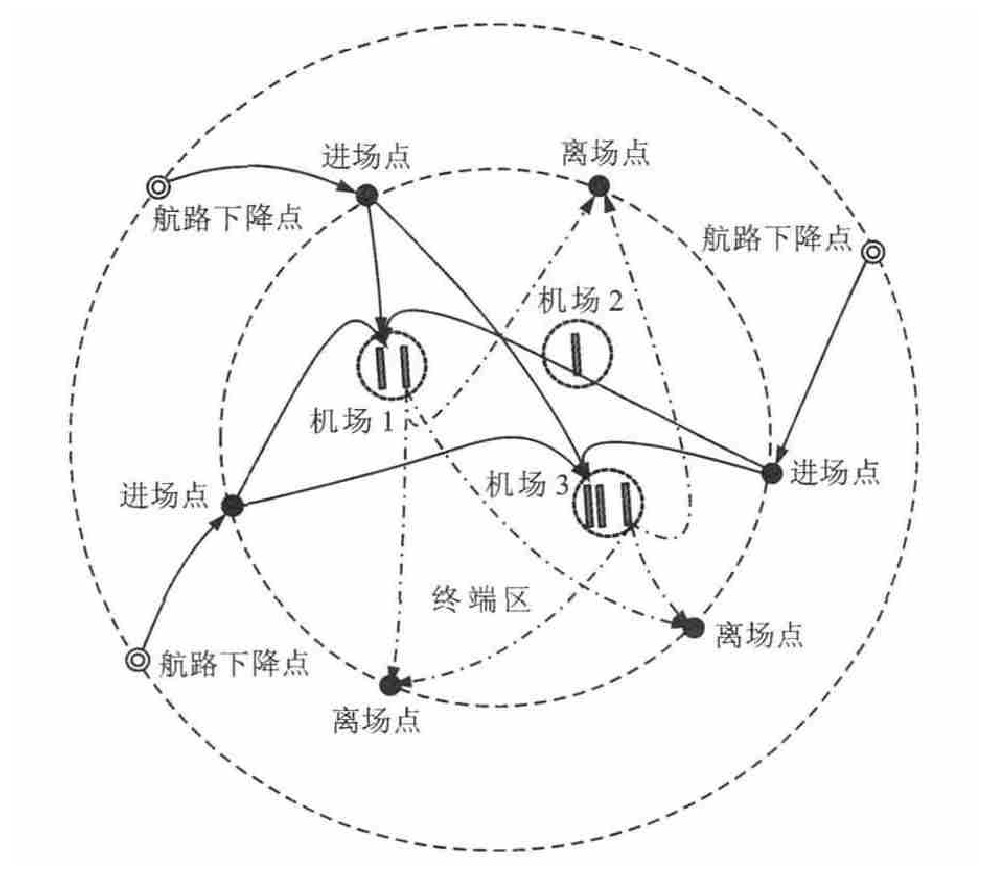Optimization model of arrival and departure resource allocation in terminal area
-
摘要: 为提高终端区运行效率和减小航班延误, 考虑了空域容量和安全间隔等约束, 以最小化航班总燃油消耗、均衡进场点等待时间和最小化航班总延误为优化目标, 建立了终端区空域进离场资源分配优化模型, 设计了带精英策略的非支配排序遗传算法, 使用上海终端区实际运行数据进行实例验证。计算结果表明: 当SASAN进场节点容量下降时, 与先到先服务策略相比, 进场点分配策略下总燃油消耗由462 282.7 kg降为337 752.9 kg, 减少了26.9%, HC、CO、NOx排放量分别由492.6、3 815.7、16 570.6 kg降为429.2、3 352.1、14 129.1 kg, 进场点总等待时间减少了93.5%, 所有航班平均延误降为104 s, 94.6%的航班的延误在600 s以内, 因此, 优化模型能有效解决终端区交通需求不均衡或节点容量下降导致的延误, 提高终端区运行效率。Abstract: In order to improve the operation efficiency of terminal area and reduce the flight delay, some factors such as airspace capacity and safety interval were considered, the minimum total flight fuel consumption, balance arrival fix holding time and minimum total flight delay were taken as optimization objectives, the optimization model of arrival and departure resource allocation in terminal area was established, the elitist non-dominated sorting genetic algorithm was designed, and example verification was carried out by using the real operation data of Shanghai terminal area.Calculation result shows that when the capacity of arrival fix SASAN decreases, compared with the first come first service(FCFS)strategy, the total fuel consumption decreases by 26.9% from 462 282.7 kg to 337 752.9 kg by using arrival fix allocation(AFA)strategy, HC, CO and NOx emissions decrease from 492.6, 3 815.7 and 16 570.6 kg to 429.2, 3 352.1 and 14 129.1 kg respectively, total arrival fix holding time decreases by 93.5%, the average delay time of all flights decreases to 104 s, and the delays of 94.6% of flights are lessthan 600 s.Obviously, the optimization model can effectively solve the delay in terminal area because of traffic demand unbalance and fix capacity decrease, and improve the operation efficiency of terminal area.
-
Key words:
- air transportation /
- terminal area /
- resource allocation /
- multi-objective optimization /
- AFA strategy /
- fuel consumption /
- emission /
- flight delay
-
表 1 恶劣天气下进场节点容量的变化
Table 1. Fluctuation of arrival fix capacities under severe weather condition

表 2 不同策略下不同延误对应的架次占比
Table 2. Flight proportion with different delay times under different strategies

-
[1] BRINTON C R. An implicit enumeration algorithm for arrival aircraft scheduling[C]//IEEE. 11th Digital Avionics Systems Conference. New York: IEEE, 1992: 268-274. [2] CARR G C, ERZBERGER H, NEUMAN F. Delay exchanges in arrival sequencing and scheduling[J]. Journal of Aircraft, 1999, 36(5): 785-791. doi: 10.2514/2.2534 [3] CARR G C, ERZBERGER H, NEUMAN F. Fast-time study of airline-influenced arrival sequencing and scheduling[J]. Journal of Guidance, Control, and Dynamics, 2000, 23(3): 526-531. doi: 10.2514/2.4559 [4] SOLVELING G, SOLAK S, CLARKE J-P, et al. Runway operations optimization in the presence of uncertainties[J]. Journal of Guidance, Control, and Dynamics, 2011, 34(5): 1373-1382. doi: 10.2514/1.52481 [5] ANAGNOSTAKIS I, CLARKE J P, BÖEHME D, et al. Runway operations planning and control: sequencing and scheduling[J]. Journal of Aircraft, 2001, 38(6): 988-996. doi: 10.2514/2.2882 [6] GILBO E P. Optimizing airport capacity utilization in air traffic flow management subject to constraints at arrival and departure fixes[J]. IEEE Transactions on Control Systems Technology, 1997, 5(5): 490-503. doi: 10.1109/87.623035 [7] SARAF A P, SLATER G L. Optimal dynamic scheduling of aircraft arrivals at congested airports[J]. Journal of Guidance, Control, and Dynamics, 2008, 31(1): 53-65. doi: 10.2514/1.29464 [8] BIANCO L, DELL'OLMO P, GIORDANI S. Scheduling models for air traffic control in terminal areas[J]. Journal of Scheduling, 2006, 9(3): 223-253. doi: 10.1007/s10951-006-6779-7 [9] KOENERS G J M, STOUT E P, RADEMAKER R M. Improving taxi traffic flow by real-time runway sequence optimization using dynamic taxi route planning[C]//IEEE. 30th Digital Avionics Systems Conference. New York: IEEE, 2011: 1-12. [10] KIM B, LI L, CLARKE J-P. Runway assignment by minimizing emissions in terminal airspace[C]//AIAA. AIAA Guidance, Navigation, and Control Conference. Reston: AIAA, 2010: 1-13. [11] KIM B, LI L, CLARKE J-P. Runway assignments that minimize terminal airspace and airport surface emissions[J]. Journal of Guidance, Control, and Dynamics, 2014, 37(3): 789-798. doi: 10.2514/1.61829 [12] BERGE M E, HARALDSDOTTIR A, SCHARL J. The multiple runway planner(MRP): modeling and analysis for arrival planning[C]//IEEE. 25th Digital Avionics Systems Conference. New York: IEEE, 2006: 1-11. [13] SIMAIAKIS I, KHADILKAR H, BALAKRISHNAN H, et al. Demonstration of reduced airport congestion through pushback rate control[J]. Transportation Research Part A: Policy and Practice, 2014, 66: 251-267. doi: 10.1016/j.tra.2014.05.014 [14] ATKIN J A D, MAERE G D, BURKE E K, et al. Addressing the pushback time allocation problem at Heathrow Airport[J]. Transportation Science, 2013, 47(4): 584-602. doi: 10.1287/trsc.1120.0446 [15] 张启钱, 胡明华, 施赛锋, 等. 多跑道航班起降调度优化算法[J]. 交通运输工程学报, 2012, 12(6): 63-68. doi: 10.3969/j.issn.1671-1637.2012.06.010ZHANG Qi-qian, HU Ming-hua, SHI Sai-feng, et al. Optimization algorithm of flight takeoff and landing on multirunways[J]. Journal of Traffic and Transportation Engineering, 2012, 12(6): 63-68. (in Chinese) doi: 10.3969/j.issn.1671-1637.2012.06.010 [16] 杨晶妹. 终端区进场航班排序方法研究[D]. 南京: 南京航空航天大学, 2010.YANG Jing-mei. Research on algorithms for scheduling arrival aircrafts in terminal area[D]. Nanjing: Nanjing University of Aeronautics and Astronautics, 2010. (in Chinese) [17] 尹嘉男, 胡明华, 彭瑛, 等. 相关进近模式下多跑道时空资源优化调度方法[J]. 航空学报, 2014, 35(11): 3064-3073. https://www.cnki.com.cn/Article/CJFDTOTAL-HKXB201411017.htmYIN Jia-nan, HU Ming-hua, PENG Ying, et al. Optimized method for multi-runway spatio-temporal resource scheduling in mode of dependent approaches[J]. Acta Aeronautica et Astronautica Sinica, 2014, 35(11): 3064-3073. (in Chinese) https://www.cnki.com.cn/Article/CJFDTOTAL-HKXB201411017.htm [18] 尹嘉男, 胡明华, 张洪海, 等. 多跑道协同运行模式优化方法[J]. 航空学报, 2014, 35(3): 795-806. https://www.cnki.com.cn/Article/CJFDTOTAL-HKXB201403021.htmYIN Jia-nan, HU Ming-hua, ZHANG Hong-hai, et al. Optimization approach for collaborative operating modes of multi-runway systems[J]. Acta Aeronautica et Astronautica Sinica, 2014, 35(3): 795-806. (in Chinese) https://www.cnki.com.cn/Article/CJFDTOTAL-HKXB201403021.htm [19] 孙浩, 胡明华, 张颖. 基于遗传算法的扇区边界尾随间隔管理方法的研究[J]. 交通运输系统工程与信息, 2010, 10(6): 174-179. doi: 10.3969/j.issn.1009-6744.2010.06.027SUN Hao, HU Ming-hua, ZHANG Ying. Research of milesin-trail strategy in sector boundary based on genetic algorithm[J]. Journal of Transportation Systems Engineering and Information Technology, 2010, 10(6): 174-179. (in Chinese) doi: 10.3969/j.issn.1009-6744.2010.06.027 [20] 夏卿. 飞机发动机排放对机场大气环境影响评估研究[D]. 南京: 南京航空航天大学, 2009.XIA Qing. Research on the atmospheric environment impact assessment from aircraft engine emissions in airport[D]. Nanjing: Nanjing University of Aeronautics and Astronautics, 2009. (in Chinese) [21] 孙见忠, 左洪福, 刘鹏鹏, 等. 航空发动机污染物排放量估算方法[J]. 交通运输工程学报, 2012, 12(2): 53-61. doi: 10.3969/j.issn.1671-1637.2012.02.009SUN Jian-zhong, ZUO Hong-fu, LIU Peng-peng, et al. Estimation method of aeroengine pollution emissions[J]. Journal of Traffic and Transportation Engineering, 2012, 12(2): 53-61. (in Chinese) doi: 10.3969/j.issn.1671-1637.2012.02.009 [22] 魏志强, 王超. 航班飞行各阶段污染物排放量估算方法[J]. 交通运输工程学报, 2010, 10(6): 48-52. doi: 10.3969/j.issn.1671-1637.2010.06.008WEI Zhi-qiang, WANG Chao. Estimating method of pollution emissions for scheduled flight in different phases[J]. Journal of Traffic and Transportation Engineering, 2010, 10(6): 48-52. (in Chinese) doi: 10.3969/j.issn.1671-1637.2010.06.008 [23] 黄勇, 吴冬莺, 王金涛, 等. 中国上空民航飞机NOx排放分布再探[J]. 北京航空航天大学学报, 2001, 27(3): 289-292. doi: 10.3969/j.issn.1001-5965.2001.03.011HUANG Yong, WU Dong-ying, WANG Jin-tao, et al. Further assessment of the NOx emission from CAAC fleet over China[J]. Journal of Beijing University of Aeronautics and Astronautics, 2001, 27(3): 289-292. (in Chinese) doi: 10.3969/j.issn.1001-5965.2001.03.011 [24] SRINIVAS N, DEB K. Multiobjective optimization using nondominated sorting in genetic algorithms[J]. Evolutionary Computation, 1994, 2(3): 221-248. doi: 10.1162/evco.1994.2.3.221 [25] DEB K, PRATAP A, AGARWAL S, et al. A fast and elitist multiobjective genetic algorithm: NSGA-Ⅱ[J]. IEEE Transactions on Evolutionary Computation, 2002, 6(2): 182-197. doi: 10.1109/4235.996017 -





 下载:
下载:














